Why you can trust Tom's Hardware
We’ve been impressed so far with other Aorus monitors’ color accuracy, and the FI27Q continues that trend with some of the best color accuracy we’ve seen of late.
Grayscale and Gamma Tracking
We describe our grayscale and gamma tests in detail here.
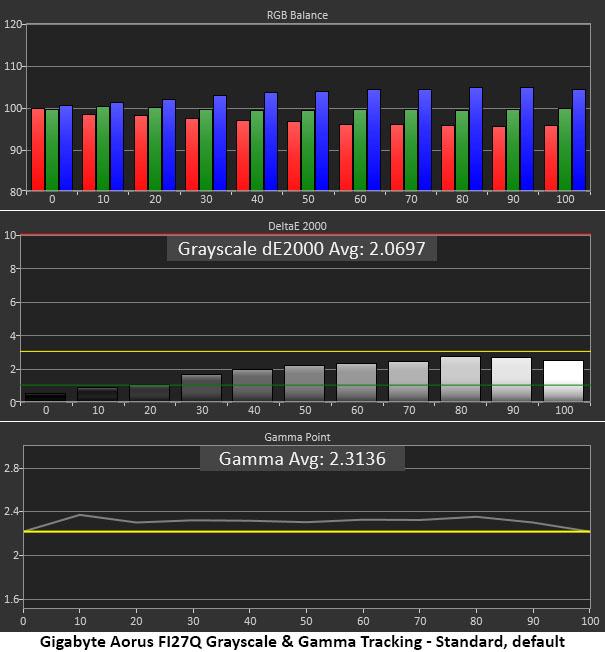
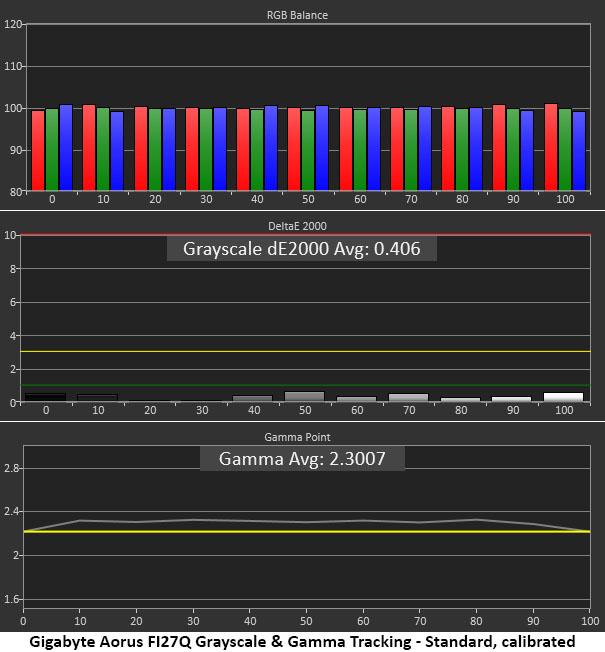
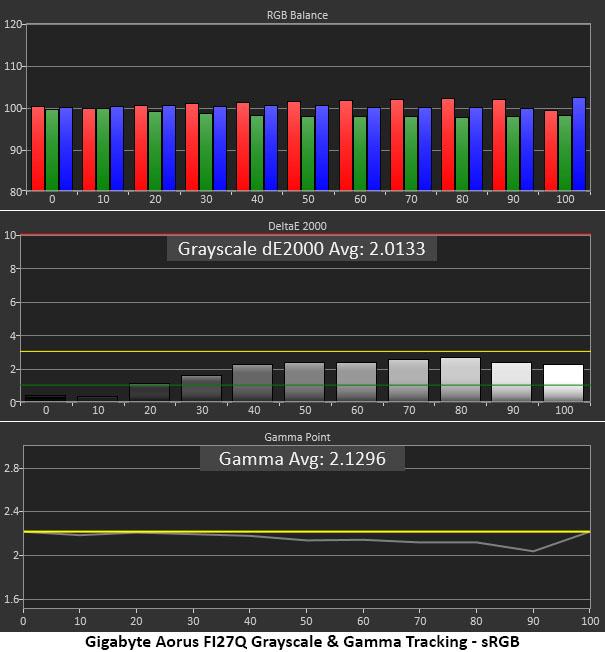
The FI27Q defaults to its full native color gamut of DCI-P3. You can view SDR material that way, and it will look more colorful but not strictly accurate. Before calibration there were no visible grayscale errors at any level of brightness. Calibration is not required; however, nit pickers will notice that gamma rode slightly above the 2.2 line, which made things look slightly dark in the mid-tones. You can compensate visually by turning up the brightness a little. The other gamma presets are further off the mark, so we suggest sticking with option 3.
Calibration produced near-perfect tracking with one of the lowest average Delta E (dE) scores we’ve recorded. It truly doesn’t get better than this. Gamma didn’t change, which, in terms of picture quality, is fine with us.
Turning on sRGB picture mode locks brightness to around 200 nits and grays out other image controls. Luckily, the mode’s pretty accurate with no visible errors in grayscale tracking and gamma that was only a tad light. We’d be fine using this mode for color-critical applications.
Comparisons
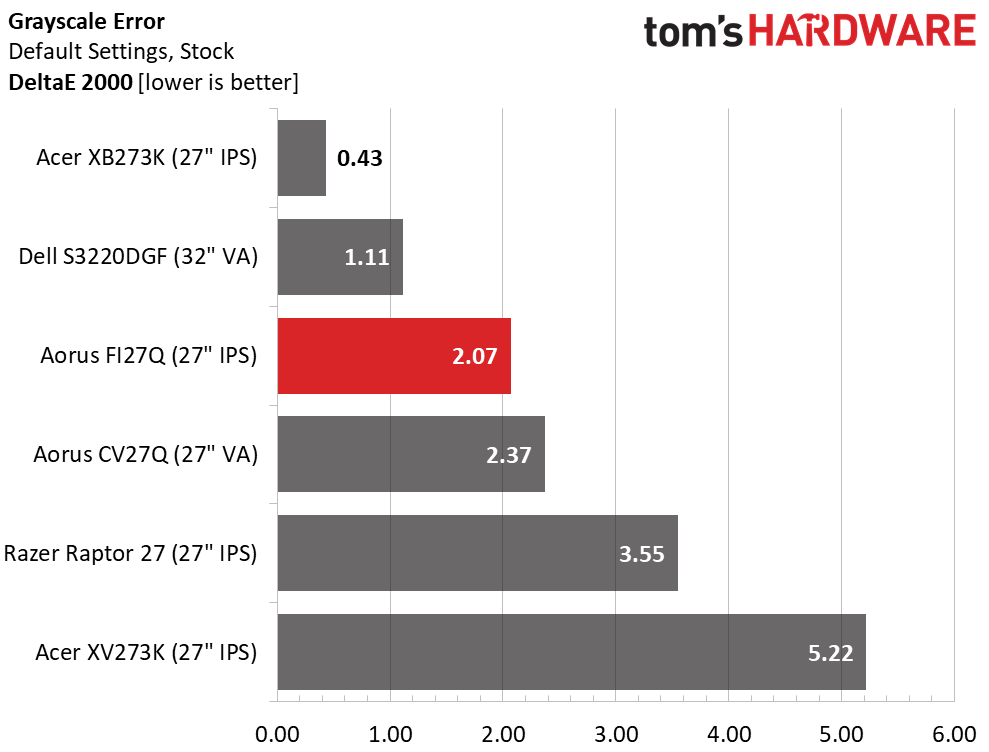

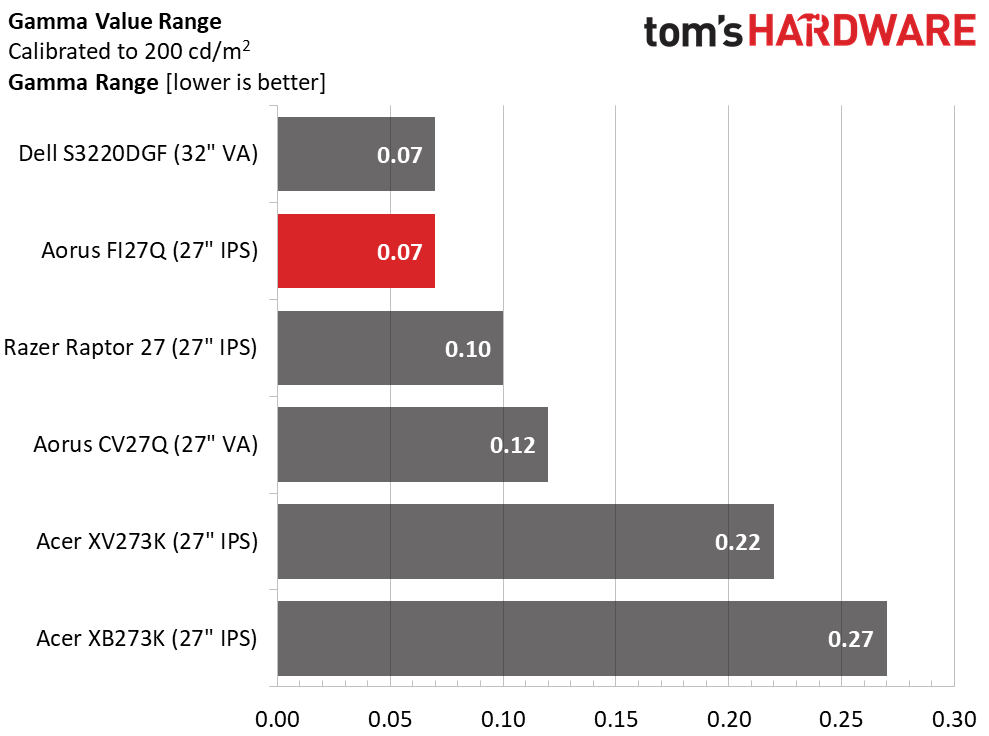
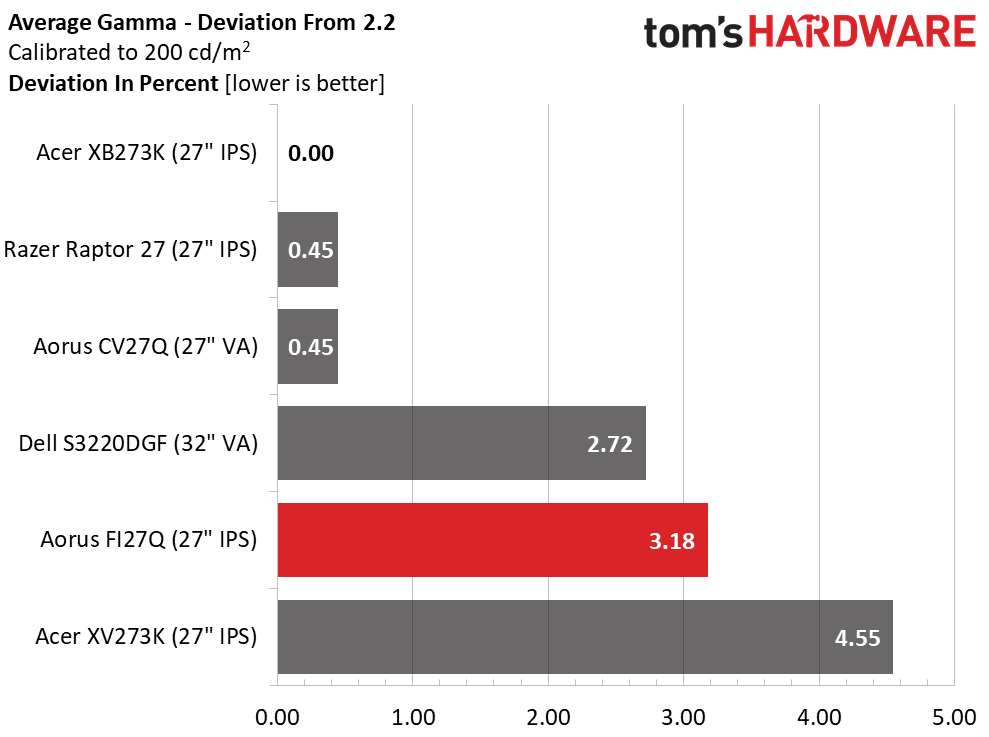
We doubt any monitors will beat the Acer XB273K’s out-of-box grayscale error score of 0.43dE. but the FI27Q acquit itself well with an average that is below the visible threshold. You won’t need to calibrate this monitor, but when we did we saw a clear gain in accuracy. If you want that last 1% of performance, a few tweaks of the RGB sliders can get you there.
Though the gamma tracking runs slightly dark, the range of values is extremely tight. This means you won’t see any brightness levels that are visibly off. Our sample measured 2.29 average, which equates to a deviation of 3.18%; very solid performance.
Get Tom's Hardware's best news and in-depth reviews, straight to your inbox.
Color Gamut Accuracy
For details on our color gamut testing and volume calculations, click here.
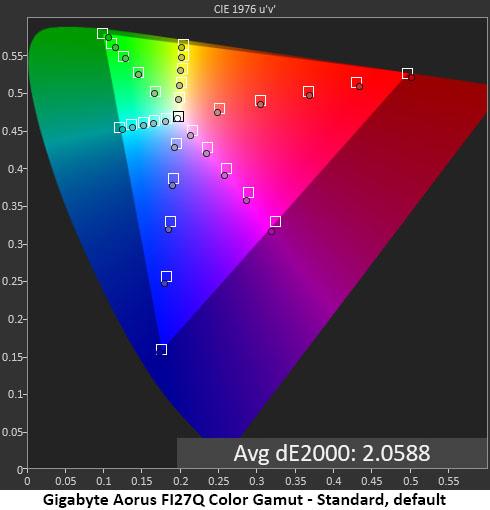
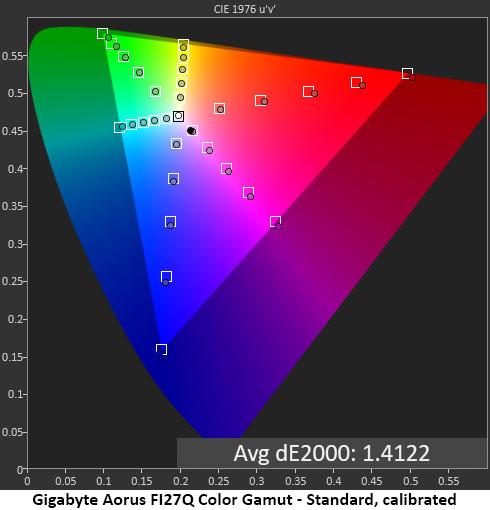
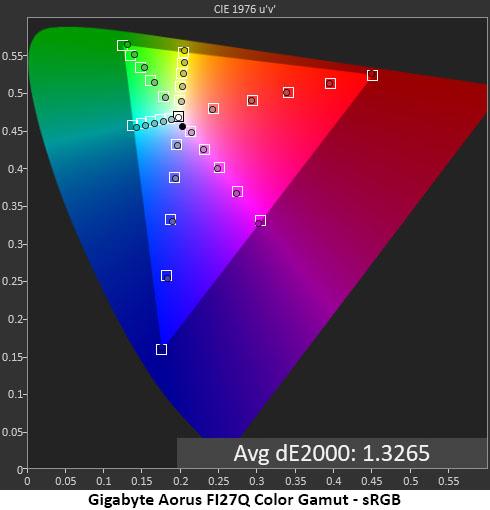
The FI27Q excels in its color gamut accuracy. Before calibration, the average error was 2.06dE which amounts to no visible error. This is measured against the DCI-P3 standard, which is the monitor’s native gamut. Though we’ve seen a few monitors that cover more of DCI, very few have hit all the saturation and hue targets so well. This is near reference-level performance.
Calibration tightened up the color targets even more. It made it so every point was inside of or in contact with the square which represents 1dE. Once again, we have to say it doesn’t get better than this. Gigabyte has maintained that accuracy in sRGB mode, which measures an impressive 1.33dE. That’s without adjustment as none are possible. While the FI27Q isn’t exactly inexpensive, it offers color performance comparable to many pricier professional screens.
Comparisons
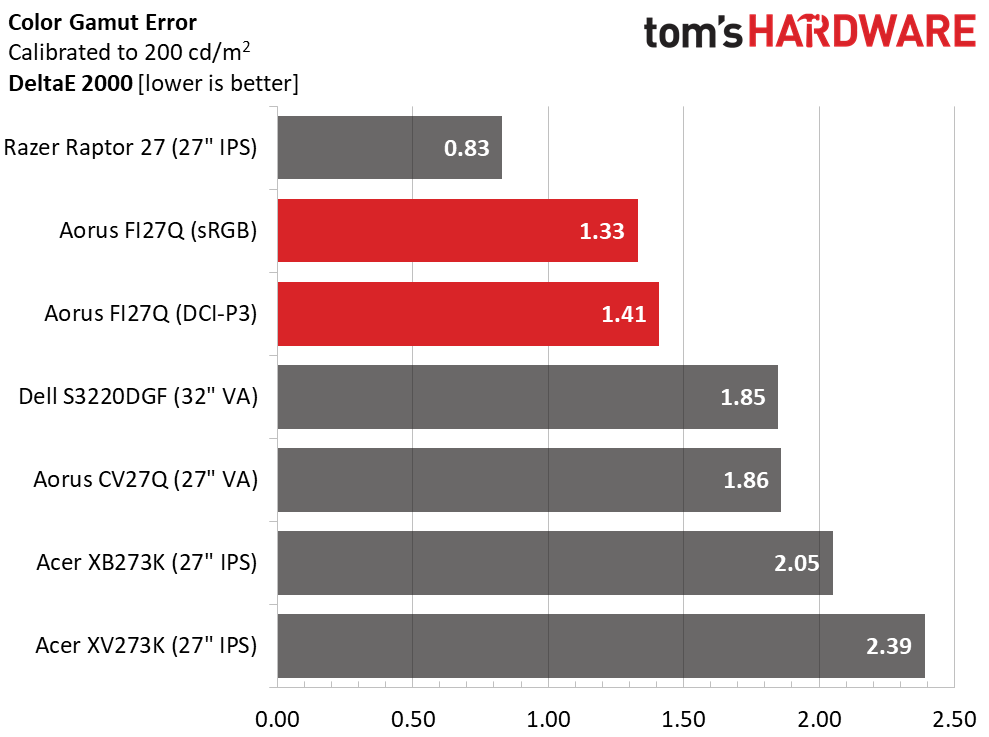
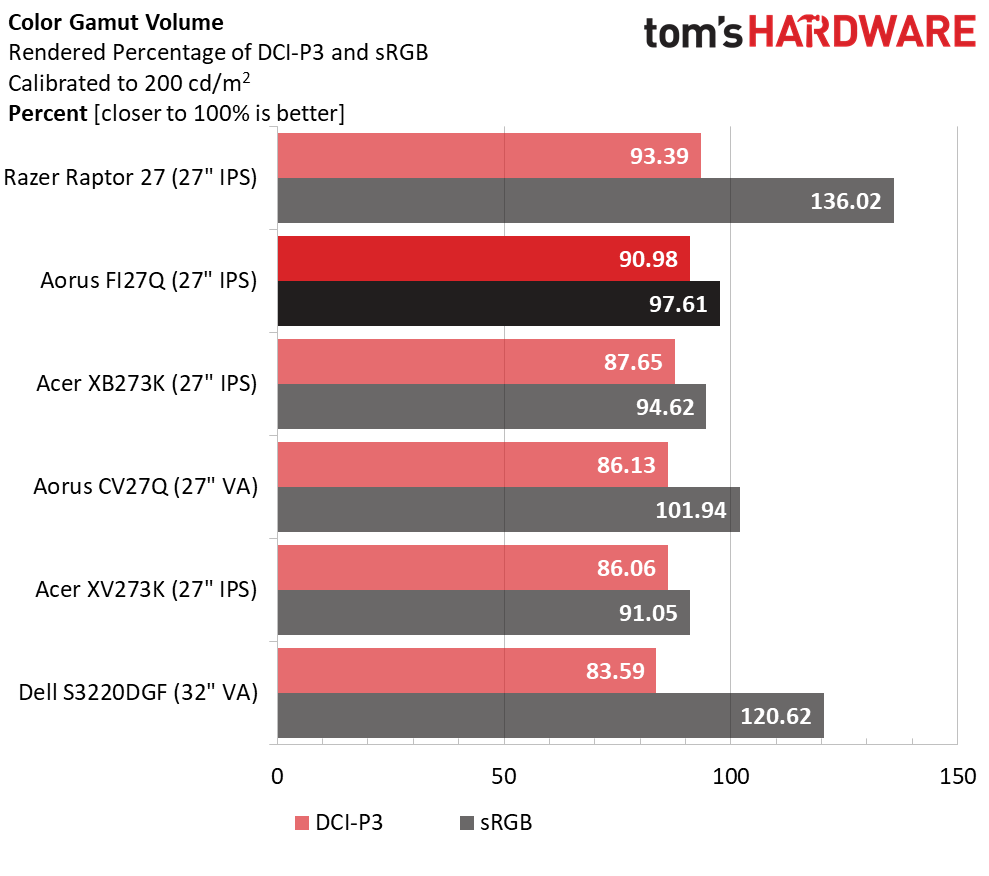
As much as we’re waxing on about the FI27Q’s color accuracy, the other monitors here compete well. Still, only the Razor Raptor boasts more accurate colors. In the gamut volume test, the FI27Q is one of the few screens we’ve seen crack the 90% DCI coverage mark. To get more coverage, you’ll need to check out the Razor Raptor or shop a high-end professional screen, like the Acer ConceptD CP7271K, which costs significantly more at $1,500 as of this writing. In both the sRGB and DCI-P3 gamuts, the FI27Q’s shortcoming is in the slightly undersaturated green primary.
MORE: Best Gaming Monitors
MORE: How We Test Monitors
MORE: All Monitor Content
Current page: Grayscale, Gamma and Color
Prev Page Brightness and Contrast Next Page HDR Performance
Christian Eberle is a Contributing Editor for Tom's Hardware US. He's a veteran reviewer of A/V equipment, specializing in monitors. Christian began his obsession with tech when he built his first PC in 1991, a 286 running DOS 3.0 at a blazing 12MHz. In 2006, he undertook training from the Imaging Science Foundation in video calibration and testing and thus started a passion for precise imaging that persists to this day. He is also a professional musician with a degree from the New England Conservatory as a classical bassoonist which he used to good effect as a performer with the West Point Army Band from 1987 to 2013. He enjoys watching movies and listening to high-end audio in his custom-built home theater and can be seen riding trails near his home on a race-ready ICE VTX recumbent trike. Christian enjoys the endless summer in Florida where he lives with his wife and Chihuahua and plays with orchestras around the state.
-
NewbieGeek I have this monitor. It is quite good. Looks beautiful. Stand is fantastic as well. My only complaints with it are a sort of hissing at high refresh rates, (not noticible with headphones) and occasional flickering (fixable with flipping the refresh rate down to 60 and back up to 165). Only seems to happy sometimes when waking from sleep. Regardless, this monitor is beautiful, smooth, and 100% recommend.Reply -
Giroro "Color banding should not be an issue either, because the FI27Q upsamples to 10-bits using Frame Rate Conversion. "Reply
The linked paged for the FI27Q-P also lists 10 Bit (8 Bit+FRC) Color Depth So I am especially unsure of the difference.
The only differences I can see on Gigabyte's pages are that FI27Q-P has display port 1.4 with something called HBR3, consumes up to 15W more power, and has a 2.1kg higher gross weight.
The Q-P page advertises "Enjoy 2K, 165Hz, HDR, 10bits color at same time!", which implies that the Q model may not be able to use all these features simultaneously. -
kokotas ReplyGiroro said:P page advertises "Enjoy 2K, 165Hz, HDR, 10bits color at same time!", which implies that the Q model may not be able to use all these features simultaneously.
gigabytegaming/comments/ctfnc7View: https://www.reddit.com/r/gigabytegaming/comments/ctfnc7/ad27q_vs_fi27q_vs_fi27qp/ -
bit_user Thanks for the review, but it's like a year late? Last November/December, they launched the FI27Q-P, which feature DisplayPort HBR3, enabling 165 Hz refresh and 10-bit, simultaneously. That's the model to buy, for anyone interested this.Reply -
bit_user Reply
Were you going to say something about that? I will. The author misunderstands how FRC works. In fact, it's just dithering 10-bit down to 8-bit. The panel is only 8-bit. So, they basically add some noise and quantize. The temporal filtering in your eye (and the LCD, to some extent) makes it look close to 10-bit.Giroro said:"Color banding should not be an issue either, because the FI27Q upsamples to 10-bits using Frame Rate Conversion."
However, if you display natively 8-bit content, a FRC display will do nothing to eliminate the banding. So, you need software that will drive the display at 10-bit. Now, how much benefit this really adds over having a game do its own dithering down to 8-bit I really can't say, but I'm a little dubious.
That's exactly it. DP 1.4 HBR3 finally has enough bandwidth to enable "165Hz, HDR, 10bits color at same time!" at 2560x1440.Giroro said:The linked paged for the FI27Q-P also lists 10 Bit (8 Bit+FRC) Color Depth So I am especially unsure of the difference.
The only differences I can see on Gigabyte's pages are that FI27Q-P has display port 1.4 with something called HBR3
Correct.Giroro said:The Q-P page advertises , which implies that the Q model may not be able to use all these features simultaneously. -
bit_user BTW, the FI27Q-P has G-Sync-compatible HDR certification, but only FreeSync Premium (not Premium Pro - their HDR certification). I have PCs with both AMD and Nvidia GPUs that I want to connect to it.Reply
Because of this and some user reviews complaining of backlight bleed near the bottom of the display, I will pass. -
vacavalier Replybit_user said:BTW, the FI27Q-P has G-Sync-compatible HDR certification, but only FreeSync Premium (not Premium Pro - their HDR certification). I have PCs with both AMD and Nvidia GPUs that I want to connect to it.
Because of this and some user reviews complaining of backlight bleed near the bottom of the display, I will pass.
Some reviewers seeing issues like backlight bleed does not mean all will or do... This unfortunately is something that will occur with TN/VA/IPS panel tech ( in varying degrees in each) as you prob know.
I've owned the F127Q-P for two weeks now... No stuck or dead pixels and zero bleed from any portion of the screen noted. Excellent picture quality and performance all around with streaming, Blu-Ray and gaming noted as well. I could have left the out-of-the-box settings in "Standard" as is, but did some calibrating to my liking, making it that much better.
I have not delved into it's "HDR" yet as it's not something I'm interested in at the moment, but is on the horizon. -
gg83 I have this monitor and I love it! I don't use the hdr anyway so I didn't care about the slightly lower brightness and contrast. It's on sale occasionally too. It's a good thing to put out review on products that have been around a bit but are still a great deal. Thanks Tom's. I have run out of content to read so now I'm posting/reading the forum.Reply -
bit_user Reply
Thanks for sharing your experience.vacavalier said:Some reviewers seeing issues like backlight bleed does not mean all will or do... This unfortunately is something that will occur with TN/VA/IPS panel tech ( in varying degrees in each) as you prob know.
For me, the bleed and lack of Freesync Premium Pro are the two issues. I know the bleed is a roll of the dice, and I'd probably take a chance on it, if the Premium Pro support were there.
But HDR is really something I want to dabble with, as a developer. And since I tend to keep monitors for a long time, I'm just not going to pull the trigger on a monitor without full HDR & VRR support from both AMD and Nvidia.
I've waited a long time to upgrade my monitor. I can wait just a bit longer, for the right one. -
rayber_50 Reply
This f12q in all its reviews , black bleeding is mentioned by experts .Both in the Q model and the P model.bit_user said:Thanks for sharing your experience.
For me, the bleed and lack of Freesync Premium Pro are the two issues. I know the bleed is a roll of the dice, and I'd probably take a chance on it, if the Premium Pro support were there.
But HDR is really something I want to dabble with, as a developer. And since I tend to keep monitors for a long time, I'm just not going to pull the trigger on a monitor without full HDR & VRR support from both AMD and Nvidia.
I've waited a long time to upgrade my monitor. I can wait just a bit longer, for the right one.
I have the Q model ,I had to pay 514.99 dollars for it at newegg . Even had a price drop of 25.00 dollars ,
And did not get my 25.00 dollar difference returned to my paypal account , just a gift card for 25.00.
Gigabyte knows about these monitor issues ,they are all over the net ,Want an all around monitor for
your 500.00 dollars , look for better quality and ask about everything before buying Nice looking monitor,
but has issues,that is the truth here.